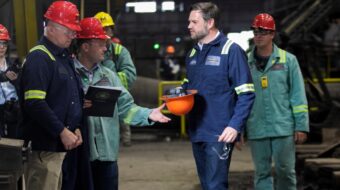The AFL-CIO jumped into the battle for a meaningful stimulus program on Jan. 6 when it issued its “Agenda to Create Jobs and Lift the Economy.” The program calls for putting more money into the hands of those who will spend it and combining it with more investment in schools, roads, bridges, financial aid to states, tax rebates targeted to low and middle-income families, extended unemployment compensation and an increase in the minimum wage.
The AFL-CIO said the program would cost about $260 billion, far less than the $300 billion that will go to the richest taxpayers if President Bush’s plan to eliminate taxes on dividends becomes law.
AFL-CIO President John Sweeney said that instead of jump starting the economy, the president’s recommendations for tax cuts will “choke off resources needed to meet the needs of American families, saddle our children with crippling debt in the future and worsen income inequalities between the very rich and the rest of us.”
Major elements of the “Agenda to Create Jobs and Lift the Economy” include:
* A 26-week retroactive extension of emergency unemployment benefits and provision of health care coverage for the unemployed.
* More financial aid to help states with health care, homeland security, education and to maintain services vital to working families.
* Creation of jobs with accelerated federal investment in schools, roads, bridges, transportation, transit, clean water and rebuilding the nation’s industrial base.
* Tax rebates for all workers, with benefits concentrated toward low – and moderate-income taxpayers.
* An increase in the federal minimum wage to correct gross the underpayment of low-wage workers, many of who work full-time, but remain poor.
The AFL-CIO proposes to pay for its plan by modifying President Bush’s 2001 tax cuts, saying, “Saving some of the resources currently slated to be spent in the future on tax cuts for the wealthy and investing them now in ways that help all Americans is the most responsible and affordable way to spur economic growth.” The labor federation says it opposes cutting taxes on dividends, making the Bush tax cuts permanent, or adding new tax breaks for business.
According to the AFL-CIO the solution is, instead, to create more demand. The Agenda approvingly quotes the chief economist for the U.S. Chamber of Commerce who said, “Two-thirds of the economy is consumption, and that’s what we’re betting on to improve growth next year.”
The AFL-CIO adds that, with some 60 percent of CEOs telling the Business Roundtable they are going to cut payrolls in 2003, government action is needed to jumpstart an economy where the unemployment is 6 percent, and 10 million unemployed workers want jobs and can’t find them and where the number of workers unemployed for more than six months continues to grow.
The labor federation plan concludes, “The fairest and most effective way to reverse 22 months of layoffs and decline and restore vitality to the American economy is with an economic recovery program designed to help those hit hardest by the downturn, create good jobs and improve wages and benefits for all working families.”
– Fred Gaboury










